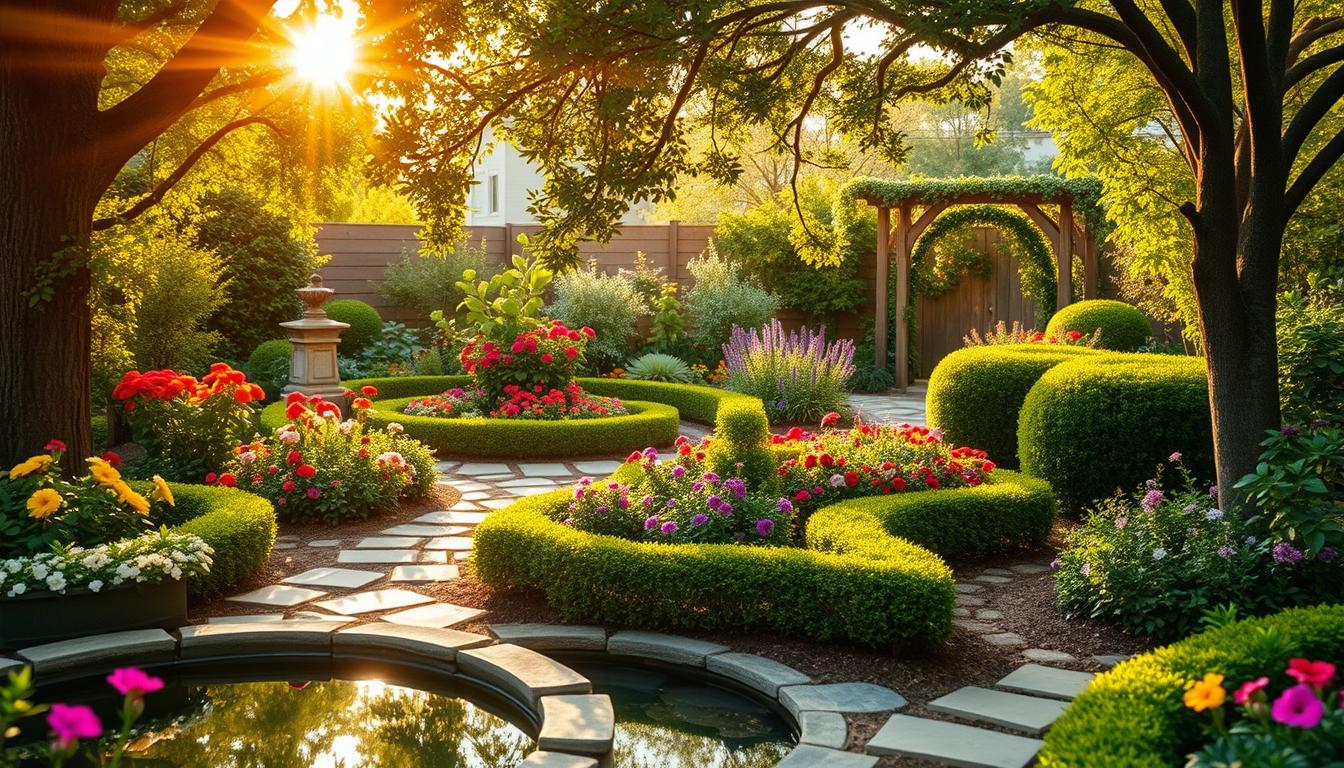Transforming your outdoor space into a stunning retreat is easier than you think. With the right ideas, even small yards can become vibrant and functional. Whether you’re a beginner or a seasoned enthusiast, there’s a plan to suit your needs.
From raised beds to drought-resistant setups, these creative layouts cater to various preferences and climates. Real-world examples from verified gardeners show how these designs can bring beauty and practicality to any space.
This guide explores themes like space optimization, plant selection, and seasonal planning. Discover how to make the most of your backyard with these 20 inspiring concepts.
Key Takeaways
- Explore 20 creative layouts for transforming outdoor spaces.
- Find designs suitable for small yards, raised beds, and kitchen gardens.
- Learn about drought-resistant setups for various climates.
- Gain insights from real-world examples by verified gardeners.
- Focus on space optimization, plant selection, and seasonal planning.
Introduction to Designing Your Garden Layout
Many people wonder where to begin when creating their ideal space. The key is to align your plans with what you want to grow and how you envision using the area. Whether you’re focused on fresh produce or a relaxing retreat, starting with clear goals makes the process easier.
With 18 years of experience, experts recommend beginning small to avoid feeling overwhelmed. This approach allows you to learn as you go and build confidence. For practical tips, the “How to Grow” series from Three Acre Farm is a great resource.
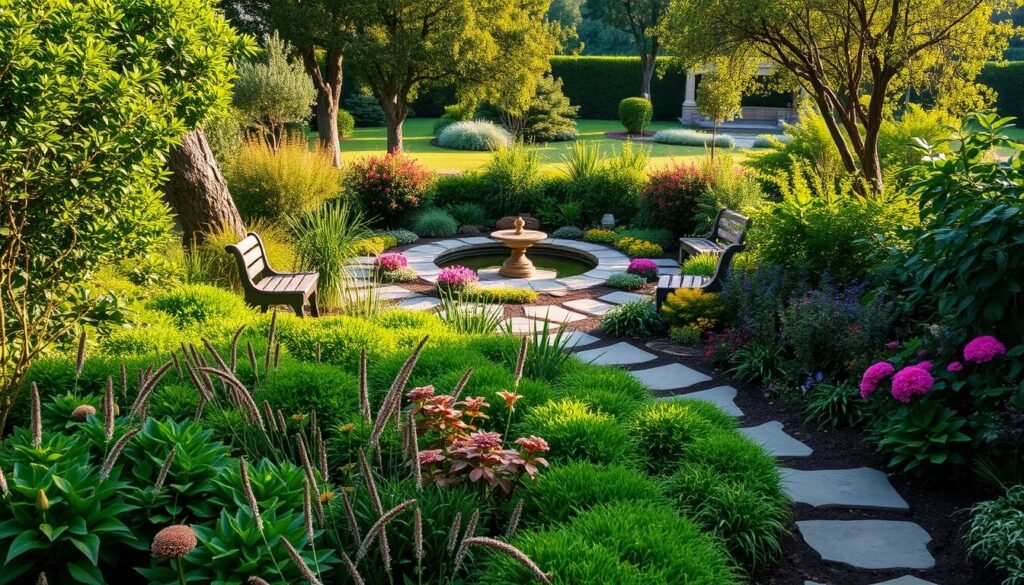
Remember, your outdoor area should reflect your personal style and needs. Take time to plan, and don’t rush the process. By focusing on what matters most to you, you’ll create a space that’s both functional and beautiful.
Why Planning is Essential for a Successful Garden
A well-thought-out plan is the foundation of any thriving outdoor area. Without proper preparation, even the best ideas can fall short. Planning ensures your space meets your needs and grows beautifully over time.
Take Lori, for example. She started with a simple 10×10 plot 15 years ago. Today, her outdoor area is a lush, productive haven. Her journey shows how starting small and planning carefully can lead to big results.

Choosing the Right Location
Selecting the right spot is crucial. Most vegetables and flowers need at least 8 hours of full sun daily. Water access is also important. Make sure your hose or irrigation system can reach every corner.
Soil quality matters too. Avoid areas with heavy clay or sandy soil. Instead, look for loamy soil that drains well and retains nutrients. If your soil isn’t ideal, consider raised beds or community garden options.
| Soil Type | Characteristics | Tips |
|---|---|---|
| Clay | Heavy, retains water | Add compost to improve drainage |
| Sandy | Light, drains quickly | Mix in organic matter to retain moisture |
| Loamy | Balanced, ideal for plants | Maintain with regular compost |
Measuring Your Space
Accurate measurements are key to maximizing your area. Raised beds, for instance, work best at 3 feet wide with 3-foot pathways. This setup ensures easy access and efficient use of space.
Sun mapping is another helpful step. Track sunlight patterns throughout the day to identify the best spots for planting. Tools like Three Acre Farm’s cutting garden templates can guide your measurements and layout.
With careful planning, your outdoor area can become a productive and beautiful retreat. Start small, measure carefully, and watch your space flourish.
Types of Garden Layouts to Consider
Exploring different setups can help you find the perfect fit for your outdoor area. Each option offers unique benefits, whether you’re working with limited space or aiming for a productive vegetable garden. Let’s dive into three popular choices.
Square-Foot Gardening
Square-foot gardening (SFG) is a compact and efficient method. It uses 4×4-foot boxes divided into a lattice pattern. This approach maximizes space by allowing more plants per square foot compared to traditional rows.
SFG is ideal for beginners or those with small areas. It reduces weeds and makes maintenance easier. Plus, it’s a great way to grow a variety of crops in a limited space.

Raised Bed Gardens
Raised beds are perfect for areas with poor soil quality. They allow you to control the soil mix, ensuring optimal conditions for your plants. These beds also improve drainage and reduce the risk of soil compaction.
Construction costs vary, but the investment pays off in productivity. Raised beds are especially useful for growing root vegetables and other crops that need loose, nutrient-rich soil.
Kitchen Gardens
A kitchen garden blends herbs, veggies, and flowers for a functional and beautiful space. This setup is perfect for those who want fresh produce right outside their door. Succession planting ensures a continuous harvest throughout the season.
Edible flowers like nasturtiums and calendula add color and flavor. They also attract pollinators, boosting the health of your plants. A kitchen garden is both practical and visually appealing.
How to Design Garden Layout for Small Spaces
Making the most of limited outdoor areas can be both fun and rewarding. With the right strategies, even the smallest spaces can become vibrant and productive. Let’s explore how to maximize every inch of your area.
Maximizing Vertical Space
Vertical gardening is a game-changer for small gardens. Trellis systems, like those from Gardenary, are perfect for growing vining plants like cucumbers and beans. They save ground space while adding height and visual interest.
Tiered planters are another great option. They’re ideal for herbs and lettuce, allowing you to grow more in less space. Pair them with a bistro-style dining setup to create a cozy, functional area.

Choosing Compact Plants
Selecting the right plants is key to success in limited areas. Dwarf fruit trees, such as citrus and apple varieties, are perfect for small spaces. They provide fresh fruit without taking up much room.
For veggies, consider patio tomatoes and bush beans. These varieties are bred to thrive in confined spaces. They’re easy to grow and produce a bountiful harvest.
| Plant Type | Space-Saving Features | Best Uses |
|---|---|---|
| Dwarf Fruit Trees | Compact size, high yield | Patios, small yards |
| Patio Tomatoes | Bushy growth, minimal space | Containers, raised beds |
| Bush Beans | Low-growing, easy to harvest | Small plots, planters |
Incorporating Raised Beds into Your Design
Raised beds are a game-changer for anyone looking to optimize their outdoor space. They offer a practical solution for improving soil quality, enhancing accessibility, and boosting plant health. Whether you’re a beginner or an experienced gardener, these structures can transform your planting setup.
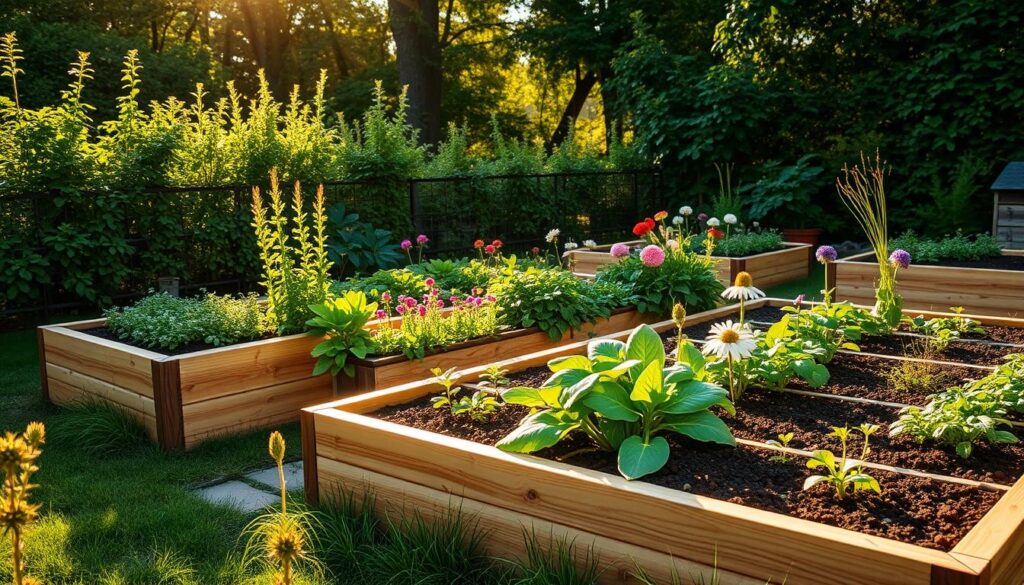
Benefits of Raised Beds
One of the biggest advantages of raised beds is their ability to improve drainage and prevent soil compaction. This creates an ideal environment for root systems to thrive. Additionally, they offer better control over soil composition, allowing you to customize the mix for your plants.
Here are some key benefits:
- Accessibility: A 3-foot width ensures easy reach from all sides, making it wheelchair-friendly.
- Thermal Benefits: The elevated structure warms up faster in spring, extending the growing season.
- Weed Control: Raised beds reduce weed growth, saving time and effort.
Building Your Own Raised Beds
Creating your own garden beds is simpler than you might think. Start by choosing the right materials. Wood is a popular choice for its natural look, while metal offers durability and a modern aesthetic.
Here’s a quick guide to get started:
- Measure Your Space: Aim for a 3-foot width for accessibility.
- Prepare the Soil Mix: Use 60% topsoil, 30% compost, and 10% potting mix.
- Assemble the Frame: Secure the materials with screws or brackets.
- Fill and Plant: Add the soil mix and start planting your favorite crops.
“Raised beds not only improve plant health but also make gardening more enjoyable and accessible.”
For companion planting, consider pairing tomatoes with basil or carrots with onions. These combinations maximize space and promote healthy growth. With the right tools and a bit of effort, your raised garden will soon become a thriving, productive space.
Using Trellises to Enhance Your Garden
Trellises are a versatile solution for maximizing your outdoor area while adding visual appeal. Whether you want grow vining vegetables or create a lush vertical display, these structures offer both functionality and beauty. They’re perfect for small spaces or anyone looking to make the most of their setup.
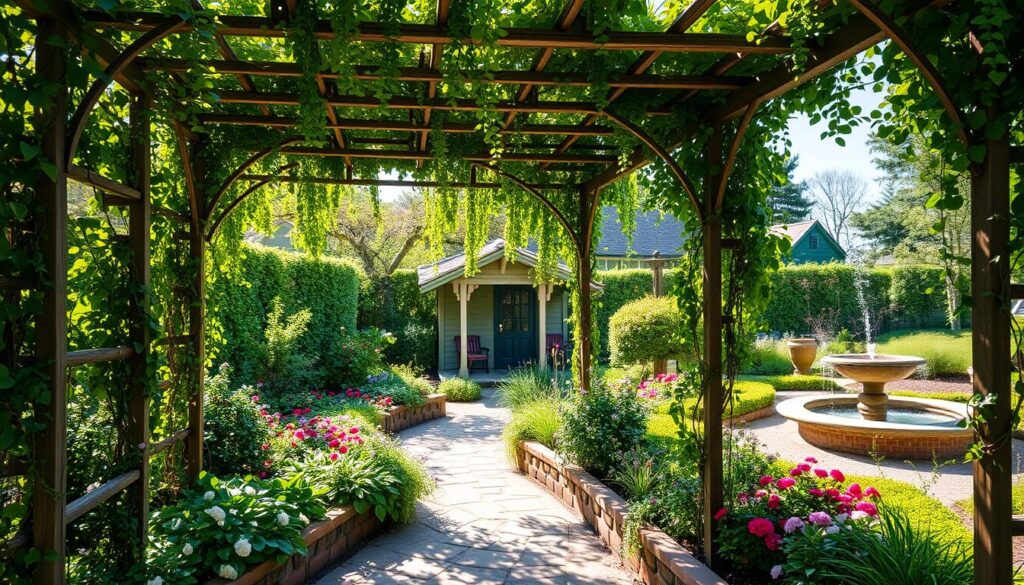
Supporting Vining Plants
Trellises are ideal for supporting plants like tomatoes, cucumbers, and pole beans. These vining crops thrive when given vertical space to climb. Studies show that trellises can increase yields by up to 40%, making them a smart choice for productive setups.
Here are some popular trellis styles to consider:
- Arched: Adds height and creates a stunning entrance.
- Ladder: Simple and effective for smaller areas.
- Obelisk: Perfect for ornamental plants and winter interest.
Increasing Growing Space
One of the biggest advantages of trellises is their ability to expand your garden space. By growing vertically, you free up ground area for other crops or features. This is especially useful for urban gardeners or those with limited room.
Pea netting is another great option for vertical growth. It’s easy to install and works well for lightweight plants like peas and beans. Pair it with a vertical herb garden to maximize your setup.
“Trellises not only save space but also create microclimates that benefit your plants.”
With thoughtful placement, trellises can shield plants from harsh winds or provide shade during hot summers. This microclimate creation ensures healthier growth and better yields. Start small, experiment with different styles, and watch your outdoor area transform.
Creating a Kitchen Garden for Fresh Produce
A kitchen garden is a practical and rewarding way to bring fresh produce right to your doorstep. It combines functionality with beauty, offering a mix of herbs, vegetables, and even edible flowers. This setup ensures you have fresh ingredients at your fingertips while enhancing your outdoor space.
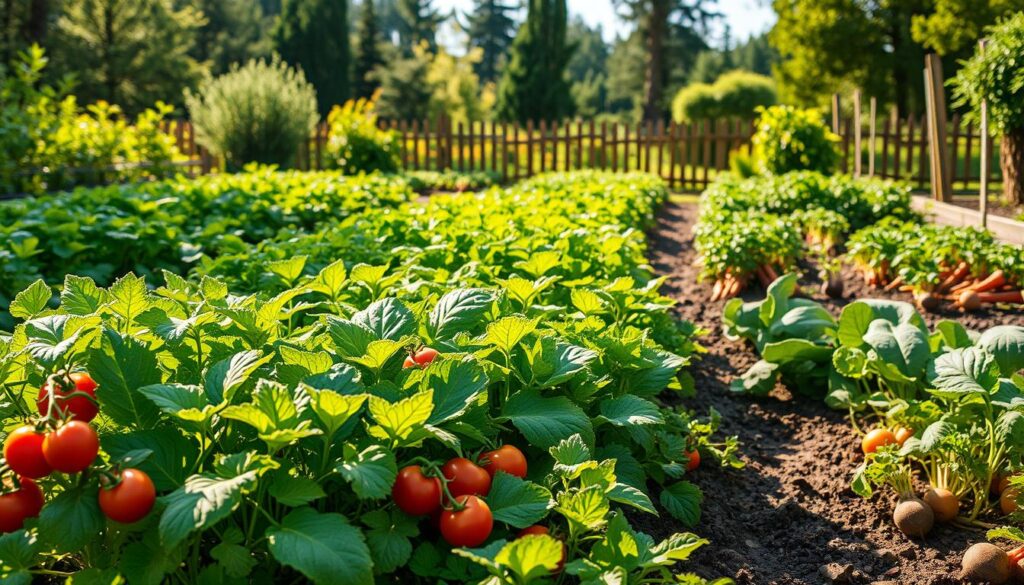
Selecting the Right Herbs and Vegetables
Choosing the right plants is essential for a thriving kitchen garden. Start with a trio of herbs like basil, thyme, and parsley. These are perfect for grilling areas and add flavor to your meals. For vegetables, consider compact varieties like patio tomatoes or bush beans, which are ideal for small spaces.
Edible flowers, such as violas and pansies, make excellent borders. They add color and can be used in salads or as garnishes. Pair them with pest-repelling herbs like rosemary and mint to keep your plants healthy.
Designing for Convenience
When planning your setup, think about accessibility and ease of use. Salad tables with built-in irrigation are a great option for growing leafy greens. They save space and ensure your plants stay hydrated.
For inspiration, check out Three Acre Farm’s “Cut Flower Confidence” course. It offers tips on creating a living tapestry of plants that are both beautiful and functional. Here are some quick tips to get started:
- Place herbs near your kitchen for easy access.
- Use vertical planters to maximize space.
- Incorporate fruit trees like dwarf citrus for fresh snacks.
With thoughtful planning, your kitchen garden can become a vibrant and productive part of your home.
Designing a Drought-Resistant Garden
A drought-resistant setup can transform your outdoor area into a sustainable haven. By focusing on water-efficient strategies, you can maintain a lush and vibrant space even in dry conditions. This approach not only conserves resources but also ensures your plants thrive with minimal effort.

Choosing Water-Efficient Plants
Selecting the right plants is crucial for a drought-resistant space. Native species are naturally adapted to local climates and require less water. Here’s a quick guide by USDA zones:
- Zone 5-7: Coneflowers, Black-eyed Susans, and Sedum.
- Zone 8-10: Lavender, Rosemary, and Agave.
These plants are not only resilient but also add beauty to your outdoor area. Pair them with gravel or wood chip mulch to retain moisture and reduce evaporation.
Implementing Irrigation Systems
Efficient watering is key to a drought-resistant setup. Drip irrigation systems deliver water directly to the roots, reducing waste by up to 50%. Another innovative option is using ollas—clay pots buried in the soil that slowly release water to plants.
Swales, shallow trenches designed to capture and redirect rainwater, are another effective method. They help retain moisture in the soil, ensuring your plants stay hydrated even during dry spells.
| Mulch Type | Benefits | Best Uses |
|---|---|---|
| Gravel | Long-lasting, excellent drainage | Succulents, xeriscaping |
| Wood Chips | Retains moisture, improves soil | Perennials, shrubs |
“Xeriscaping principles focus on reducing water use while creating a beautiful and functional space.”
By combining these strategies, you can create a sustainable and thriving outdoor area that’s both practical and visually appealing.
Companion Planting for a Healthier Garden
Companion planting is a natural way to boost plant health and productivity. By pairing certain plants together, you can create a balanced ecosystem that benefits all involved. This method reduces pests, improves soil quality, and maximizes space efficiently.

Benefits of Companion Planting
One of the biggest advantages of companion planting is pest control. For example, marigolds can reduce nematodes by up to 90%. They release a natural chemical that repels these harmful pests. Additionally, certain plant combinations can attract beneficial insects like pollinators, which enhance growth.
Another benefit is improved soil health. Plants like beans fix nitrogen in the soil, making it available for neighboring crops. This natural fertilization reduces the need for chemical additives. Companion planting also helps with space optimization, allowing you to grow more in less area.
Popular Companion Plant Combinations
Here are some tried-and-true pairings to consider:
- Tomato, Basil, and Marigold: This trio deters pests and enhances flavor.
- Corn, Beans, and Squash: Known as the Three Sisters method, this combination supports mutual growth.
- Radishes and Cucumbers: Radishes act as trap crops, luring pests away from cucumbers.
For shade partnerships, try planting spinach under corn. The corn provides shade, while the spinach thrives in cooler conditions. Avoid allelopathic plants like black walnut, which release chemicals that inhibit the growth of nearby plants.
“Companion planting not only improves plant health but also creates a more sustainable and productive space.”
By experimenting with these combinations, you can create a thriving and harmonious outdoor area. Start small, observe the results, and enjoy the benefits of this natural gardening technique.
Adding Flowers to Your Garden Layout
Brighten your outdoor space with vibrant blooms that attract life and color. Flowers not only enhance the beauty of your area but also support pollinators like bees. Whether you’re a beginner or an experienced enthusiast, adding flowers can transform your setup into a lively retreat.
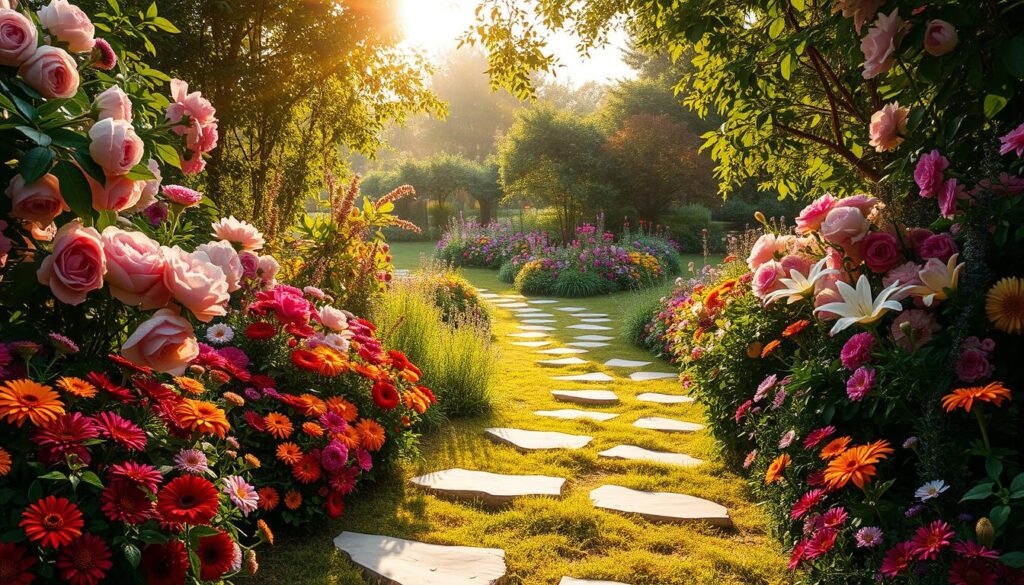
Selecting Beginner-Friendly Flowers
For new gardeners, choosing easy-to-grow varieties is key. Zinnias, for example, are a fantastic option. Studies show they increase pollinator visits by 70%, making them both beautiful and beneficial. Other beginner-friendly choices include marigolds, sunflowers, and cosmos.
Here’s a quick guide to get started:
- Zinnias: Vibrant colors, low maintenance, and pollinator-friendly.
- Marigolds: Deer-resistant and great for pest control.
- Sunflowers: Tall and striking, perfect for borders.
Designing for Aesthetic Appeal
Creating a visually appealing display involves thoughtful planning. Use the color wheel theory to pair complementary shades. For example, purple and yellow flowers create a striking contrast. Bloom succession planning ensures continuous color throughout the season.
Here are some deer-resistant varieties to consider:
| Flower | Color | Best Use |
|---|---|---|
| Lavender | Purple | Borders, pathways |
| Salvia | Blue, red | Pollinator gardens |
| Snapdragons | Mixed | Cut flower arrangements |
For a bouquet-inspired layout, group flowers by height and color. This creates a cohesive and eye-catching display. Don’t forget to explore flower drying techniques to preserve your blooms for year-round enjoyment.
“Flowers are the music of the ground. From earth’s lips spoken without sound.”
With these tips, you can create a stunning and functional space that’s both beautiful and beneficial. Start small, experiment with different varieties, and watch your area come to life.
Planning for Seasonal Changes in Your Garden
Adapting your outdoor space to the changing seasons ensures year-round beauty and productivity. By understanding the unique needs of each season, you can create a dynamic and thriving setup that evolves with the time of year. Whether you’re preparing for the chill of winter or maximizing growth in the summer heat, thoughtful planning makes all the difference.

Preparing for Winter
Winter doesn’t have to mean an empty space. Start by constructing a cold frame to protect your plants from frost. These simple structures trap heat, extending the growing season for hardy crops like kale and Brussels sprouts. These frost-tolerant vegetables thrive in cooler temperatures and can even improve in flavor after a light frost.
For holiday decorations, consider adding plants like holly, evergreens, or winterberry. These not only add festive cheer but also provide visual interest during the colder months. Soil solarization is another effective technique to prepare for spring. Covering your beds with plastic sheeting helps eliminate pests and weeds, giving you a fresh start when the weather warms.
Maximizing Summer Growth
Summer is the perfect time to focus on abundant growth. Succession planting ensures a continuous harvest throughout the season. Start with cool-weather crops like lettuce and spinach, then transition to warm-weather favorites like tomatoes and peppers. This method keeps your space productive and avoids gaps in your harvest.
Here’s a quick succession planting schedule to follow:
- Early Spring: Plant peas, radishes, and spinach.
- Late Spring: Transition to beans, cucumbers, and squash.
- Summer: Focus on tomatoes, peppers, and eggplants.
“Succession planting not only maximizes space but also ensures a steady supply of fresh produce all summer long.”
By planning for seasonal changes, you can create a space that’s both beautiful and productive throughout the year. Start small, experiment with different techniques, and enjoy the rewards of a well-planned outdoor area.
Tools and Materials You’ll Need for Garden Design
Having the right tools and materials can make all the difference in creating a thriving outdoor space. Whether you’re starting a new project or maintaining an existing one, the proper equipment ensures efficiency and success. From ergonomic tools to nutrient-rich soil, these essentials will set you up for a rewarding experience.
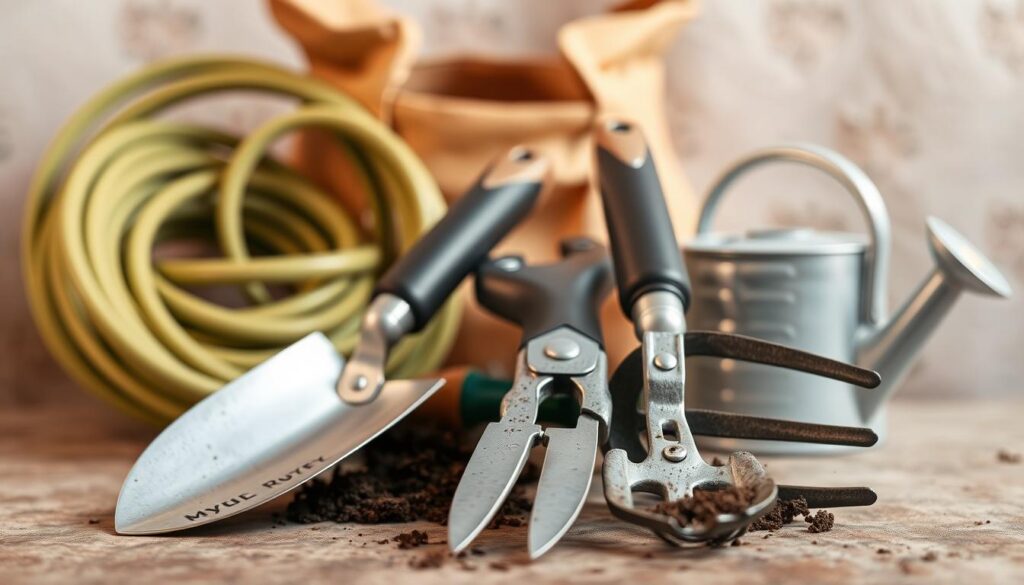
Essential Gardening Tools
Every gardener needs a reliable set of tools to get the job done. Ergonomic options, like those from Three Acre Farm, reduce strain and make tasks easier. Here’s a must-have list:
- Hand Trowel: Perfect for planting and transplanting.
- Pruning Shears: Essential for trimming and shaping plants.
- Garden Fork: Great for turning compost and aerating soil.
- Watering Can: Ensures even hydration for your plants.
Maintaining your tools is just as important. Clean and sharpen them regularly to extend their lifespan. For comfort, consider knee pad alternatives like foam mats or padded stools.
Choosing the Right Soil and Compost
Healthy plants start with quality soil. A soil test kit can help you determine nutrient levels and pH balance. This ensures your plants get the right environment to thrive. Adding compost improves soil structure and fertility.
Compost tea is another excellent option. Brewing it involves steeping compost in water to create a nutrient-rich liquid. This natural fertilizer boosts plant health and encourages growth. Here’s a quick guide to organic fertilizer NPK ratios:
| Fertilizer Type | NPK Ratio | Best Uses |
|---|---|---|
| Fish Emulsion | 5-1-1 | Leafy greens, herbs |
| Bone Meal | 3-15-0 | Root vegetables, flowering plants |
| Kelp Meal | 1-0-2 | Overall plant health |
“Healthy soil is the foundation of a thriving garden. Invest in quality compost and fertilizers to see the best results.”
For raised beds, ensure your soil mix includes 60% topsoil, 30% compost, and 10% potting mix. This combination provides the perfect balance for plant growth. With the right tools and materials, your outdoor space will flourish season after season.
Conclusion: Bring Your Garden Layout Ideas to Life
Bringing your outdoor vision to life starts with thoughtful planning and creativity. By following the key steps outlined, you can create a space that thrives throughout the year. Start small, measure your area, and choose plants that suit your climate and goals.
For ongoing support, consider joining Gardenary’s vibrant community. Their Backyard Cutting Garden 101 course offers expert guidance to help you achieve success. Documenting your progress with photos can also inspire and motivate you as your space evolves.
Ready to take the next step? Explore more boho yard decor ideas to add personality to your setup. Remember, every great space begins with a single idea. Your dream retreat is within reach—start today!

